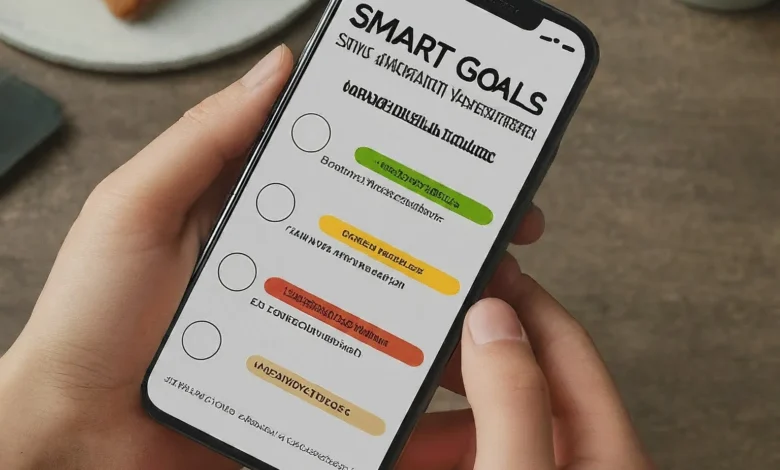The SMART Goals Framework for Achieving Work-Life Balance

Are you feeling overwhelmed, trying to juggle your career and personal life? You’re not alone. A recent study by the American Psychological Association found that 66% of workers struggle to maintain a healthy work-life balance. But what if there was a simple, effective way to bring harmony to your professional and personal worlds? Enter the SMART goals framework – a powerful tool that can help you achieve the work-life balance you’ve been dreaming of.
Introduction
Imagine this: You’re excelling at work, spending quality time with loved ones, pursuing your passions, and still finding time for self-care. Sounds too good to be true? It doesn’t have to be. Work-life balance is not just a buzzword; it’s a crucial aspect of our overall well-being. The key to unlocking this balance might be simpler than you think – SMART goals.
In this article, we’ll explore how the SMART goals framework can be your secret weapon in achieving work-life balance. We’ll break down each component of SMART goals and show you how to apply them to create a more balanced, fulfilling life. Get ready to transform your approach to work-life balance and take control of your time and energy!
Understanding Work-Life Balance
Let’s start by clarifying what we mean by work-life balance. Work-life balance is the state of equilibrium where a person equally prioritizes the demands of one’s career and personal life. It’s about finding that sweet spot where you can be productive at work without sacrificing your personal life and vice versa.
Why is maintaining a healthy work-life balance so important? Here are a few key reasons:
- Improved mental health
- Increased productivity
- Better physical health
- Enhanced relationships
- Greater job satisfaction
Despite its importance, achieving work-life balance is easier said than done. Many of us face common challenges such as:
- Long working hours
- Technology blurring the lines between work and personal time
- Difficulty saying “no” to additional responsibilities
- Perfectionism leading to overwork
- Lack of clear boundaries between work and personal life
These challenges can seem daunting, but that’s where SMART goals come in. By applying this framework to your work-life balance goals, you can create a clear, actionable plan to overcome these obstacles and create the balanced life you desire.
What are SMART Goals?
SMART is an acronym that stands for Specific, Measurable, Achievable, Relevant, and Time-bound. This goal-setting framework was first introduced by George T. Doran in 1981 and has since become a popular tool in various fields, including personal development and business management.
SMART goals are effective because they:
- Provide clear direction and focus
- Make it easier to track progress
- Increase motivation and commitment
- Improve the likelihood of goal achievement
Applying SMART Goals to Work-Life Balance
Let’s break down each component of SMART goals and see how they can be applied to achieve better work-life balance.
Specific
When it comes to work-life balance, setting specific goals is crucial. Instead of a vague goal like “improve work-life balance,” you need to pinpoint exactly what you want to achieve.
Examples of specific work-life balance goals:
- Spend at least one hour of quality time with family every weekday evening
- Dedicate 30 minutes each day to a personal hobby or interest
- Limit work-related emails to office hours only
To make your work-life balance goals more specific:
- Identify exactly what you want to accomplish
- Determine who is involved
- Specify where and when the goal will be achieved
Measurable
Measurable goals allow you to track your progress and stay motivated. For work-life balance, this often involves quantifying time or frequency.
Examples of measurable work-life balance goals:
- Reduce overtime hours by 50% within three months
- Take a full lunch break away from the desk 4 out of 5 workdays
- Engage in stress-reducing activities for 15 minutes daily
Tools and techniques for measuring progress:
- Time-tracking apps (e.g., RescueTime, Toggl)
- Journal or log to record activities and feelings
- Regular self-assessments or check-ins
Achievable
Setting achievable goals is about striking a balance between ambition and realism. It’s important to challenge yourself while ensuring your goals are within reach.
How to assess if a goal is achievable:
- Evaluate your current situation and resources
- Consider potential obstacles and how to overcome them
- Break down larger goals into smaller, manageable steps
- Seek feedback from trusted friends, family, or mentors
Remember, the key is to set goals that stretch you but don’t break you. Start with small, achievable goals and gradually increase the challenge as you progress.
Relevant
Relevant goals align with your personal values, long-term objectives, and current life stage. When it comes to work-life balance, relevance is about ensuring your goals truly matter to you.
Questions to ask when determining goal relevance:
- Does this goal align with my core values?
- Will achieving this goal significantly improve my work-life balance?
- Is this goal appropriate for my current life stage and circumstances?
- Does this goal support my long-term career and personal aspirations?
- Am I genuinely motivated to achieve this goal?
- Will this goal have a positive impact on my overall well-being?
Examples of relevant work-life balance goals for different life stages:
- Young professional: Establish a morning routine that includes exercise and meditation
- Parent of young children: Create a flexible work schedule to attend important family events
- Mid-career professional: Develop a new skill or hobby unrelated to work
- Near retirement: Gradually reduce work hours to transition into retirement
Time-bound
Setting deadlines for your work-life balance goals creates a sense of urgency and helps you prioritize your efforts.
Short-term vs. long-term work-life balance goals:
| Short-term Goals | Long-term Goals |
|---|---|
| Achieve within weeks or months | Achieve within years |
| Focus on immediate improvements | Focus on lasting lifestyle changes |
| Example: Take a lunch break away from desk daily | Example: Transition to a more flexible career |
Tips for setting appropriate timelines:
- Be realistic about how long changes take
- Start with shorter timeframes and adjust as needed
- Review and revise your timelines regularly
- Celebrate small milestones along the way
By applying these SMART goal principles to your work-life balance aspirations, you’re setting yourself up for success. In the next section, we’ll guide you through creating your own SMART work-life balance plan.
Creating Your SMART Work-Life Balance Plan
Now that we understand how SMART goals apply to work-life balance, let’s create a step-by-step plan to put this knowledge into action.
- Assess your current situation: Take an honest look at your current work-life balance. Identify areas that need improvement.
- Define your ideal work-life balance: Visualize what a perfect balance would look like for you.
- Brainstorm potential goals: List all the changes you’d like to make, big and small.
- Apply the SMART criteria: For each goal, ensure it meets all SMART criteria (Specific, Measurable, Achievable, Relevant, Time-bound).
- Prioritize your goals: Choose 2-3 goals to focus on initially. Starting small increases your chances of success.
- Create an action plan: Break down each goal into specific tasks or milestones.
- Set up a tracking system: Decide how you’ll monitor your progress (e.g., apps, journals, regular check-ins).
- Identify potential obstacles: Anticipate challenges and plan how to overcome them.
- Seek support: Share your goals with friends, family, or a mentor who can offer encouragement and accountability.
Common pitfalls to avoid:
- Setting too many goals at once
- Being overly ambitious with timelines
- Neglecting to review and adjust goals regularly
- Forgetting to celebrate small victories
Sample SMART work-life balance goal:
Specific: Reduce work-related screen time in the evenings
Measurable: Limit work email and calls to 30 minutes max between 7-9 PM
Achievable: Use app blockers and set clear boundaries with colleagues
Relevant: Aligns with desire for more quality family time and better sleep
Time-bound: Implement fully within 4 weeks, with gradual reduction each week
Implementing and Adjusting Your SMART Goals
Once you’ve created your SMART work-life balance plan, it’s time to put it into action and stay on track.
Strategies for staying motivated:
- Visualize success regularly
- Track and celebrate small wins
- Find an accountability partner or join a support group
- Remind yourself of the ‘why’ behind your goals
How to track progress effectively:
- Use a goal-tracking app like Strides or Coach.me
- Keep a weekly journal to reflect on challenges and successes
- Schedule regular check-ins with yourself or an accountability partner
When and how to adjust your goals:
It’s important to remember that flexibility is key in maintaining work-life balance. Life changes, and your goals should adapt accordingly. Here’s when and how to adjust:
- Review your goals monthly: Are they still relevant and achievable?
- Assess your progress quarterly: Are you moving in the right direction?
- Make adjustments as needed: Don’t be afraid to modify goals if circumstances change
- Learn from setbacks: Use challenges as opportunities to refine your approach
Remember, the journey to better work-life balance is ongoing. Be patient with yourself and celebrate the progress you make along the way.
Conclusion
Achieving work-life balance is a journey, not a destination. By using the SMART goals framework, you’ve equipped yourself with a powerful tool to navigate this journey more effectively. Let’s recap the key points we’ve covered:
- Work-life balance is crucial for overall well-being and success.
- SMART goals provide a structured approach to achieving work-life balance.
- Specific goals help you focus on exactly what you want to achieve.
- Measurable objectives allow you to track your progress.
- Achievable goals keep you motivated and prevent burnout.
- Relevant goals ensure you’re working towards what truly matters to you.
- Time-bound goals create urgency and help you prioritize.
Remember, the path to better work-life balance is unique for everyone. What works for one person may not work for another. The beauty of the SMART framework is its flexibility – you can adapt it to fit your specific needs and circumstances.
As you embark on this journey, be kind to yourself. Perfection isn’t the goal; progress is. Celebrate small wins, learn from setbacks, and keep moving forward. With persistence and the right approach, you can create a life that feels balanced, fulfilling, and authentically yours.
Call-to-Action
Now that you’re armed with the knowledge of how to use SMART goals for work-life balance, it’s time to take action! Here’s what you can do right now:
- Start small: Choose one area of your work-life balance you want to improve.
- Create a SMART goal: Use the framework we’ve discussed to formulate a clear, achievable goal.
- Write it down: Put your goal somewhere you’ll see it daily.
- Share your commitment: Tell a friend or family member about your goal for added accountability.
- Take the first step: Identify one action you can take today towards your goal, no matter how small.
Remember, the journey of a thousand miles begins with a single step. Your journey to better work-life balance starts now!
We’d love to hear about your experiences with using SMART goals for work-life balance. Have you tried this approach before? What worked for you? What challenges did you face? Share your thoughts in the comments below or reach out to us on social media.
And if you found this article helpful, why not share it with a friend or colleague who might benefit from it too? Together, we can create a community committed to achieving better work-life balance.
Here’s to your success in creating a more balanced, fulfilling life!


